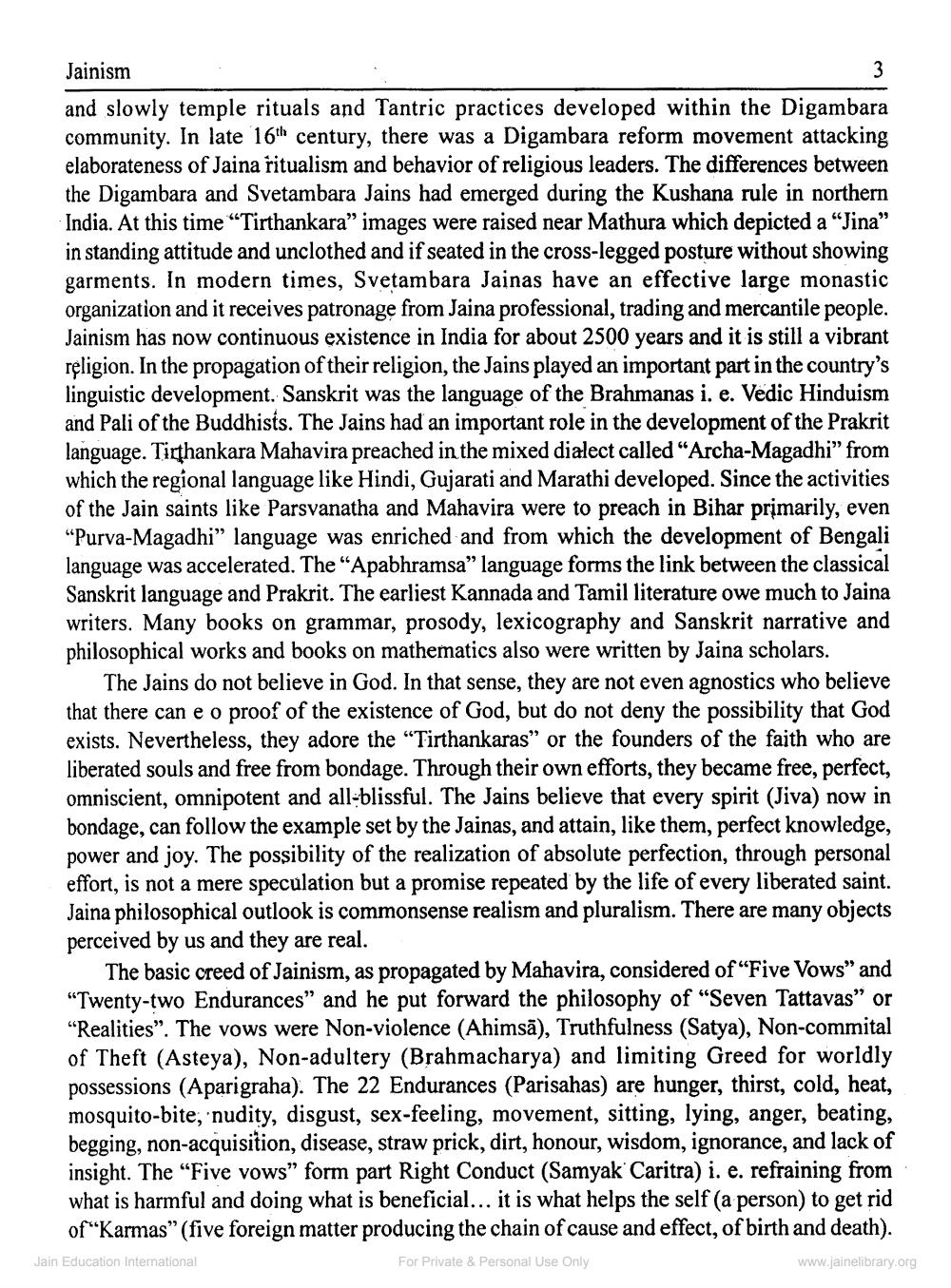________________
Jainism
and slowly temple rituals and Tantric practices developed within the Digambara community. In late 16th century, there was a Digambara reform movement attacking elaborateness of Jaina ritualism and behavior of religious leaders. The differences between the Digambara and Svetambara Jains had emerged during the Kushana rule in northern India. At this time "Tirthankara” images were raised near Mathura which depicted a "Jina" in standing attitude and unclothed and if seated in the cross-legged posture without showing garments. In modern times, Svetambara Jainas have an effective large monastic organization and it receives patronage from Jaina professional, trading and mercantile people. Jainism has now continuous existence in India for about 2500 years and it is still a vibrant religion. In the propagation of their religion, the Jains played an important part in the country's linguistic development. Sanskrit was the language of the Brahmanas i. e. Vedic Hinduism and Pali of the Buddhists. The Jains had an important role in the development of the Prakrit language. Ticthankara Mahavira preached in the mixed dialect called "Archa-Magadhi" from which the regional language like Hindi, Gujarati and Marathi developed. Since the activities of the Jain saints like Parsvanatha and Mahavira were to preach in Bihar primarily, even "Purva-Magadhi" language was enriched and from which the development of Bengali language was accelerated. The “Apabhramsa" language forms the link between the classical Sanskrit language and Prakrit. The earliest Kannada and Tamil literature owe much to Jaina writers. Many books on grammar, prosody, lexicography and Sanskrit narrative and philosophical works and books on mathematics also were written by Jaina scholars.
The Jains do not believe in God. In that sense, they are not even agnostics who believe that there can e o proof of the existence of God, but do not deny the possibility that God exists. Nevertheless, they adore the “Tirthankaras” or the founders of the faith who are liberated souls and free from bondage. Through their own efforts, they became free, perfect, omniscient, omnipotent and all-blissful. The Jains believe that every spirit (Jiva) now in bondage, can follow the example set by the Jainas, and attain, like them, perfect knowledge, power and joy. The possibility of the realization of absolute perfection, through personal effort, is not a mere speculation but a promise repeated by the life of every liberated saint. Jaina philosophical outlook is commonsense realism and pluralism. There are many objects perceived by us and they are real.
The basic creed of Jainism, as propagated by Mahavira, considered of “Five Vows" and "Twenty-two Endurances" and he put forward the philosophy of "Seven Tattavas" or “Realities”. The vows were Non-violence (Ahimsā), Truthfulness (Satya), Non-commital of Theft (Asteya), Non-adultery (Brahmacharya) and limiting Greed for worldly possessions (Aparigraha). The 22 Endurances (Parisahas) are hunger, thirst, cold, heat, mosquito-bite, 'nudity, disgust, sex-feeling, movement, sitting, lying, anger, beating, begging, non-acquisition, disease, straw prick, dirt, honour, wisdom, ignorance, and lack of insight. The "Five vows” form part Right Conduct (Samyak Caritra) i. e. refraining from what is harmful and doing what is beneficial... it is what helps the self (a person) to get rid
of "Karmas" (five foreign matter producing the chain of cause and effect, of birth and death). Jain Education International For Private & Personal Use Only
www.jainelibrary.org




